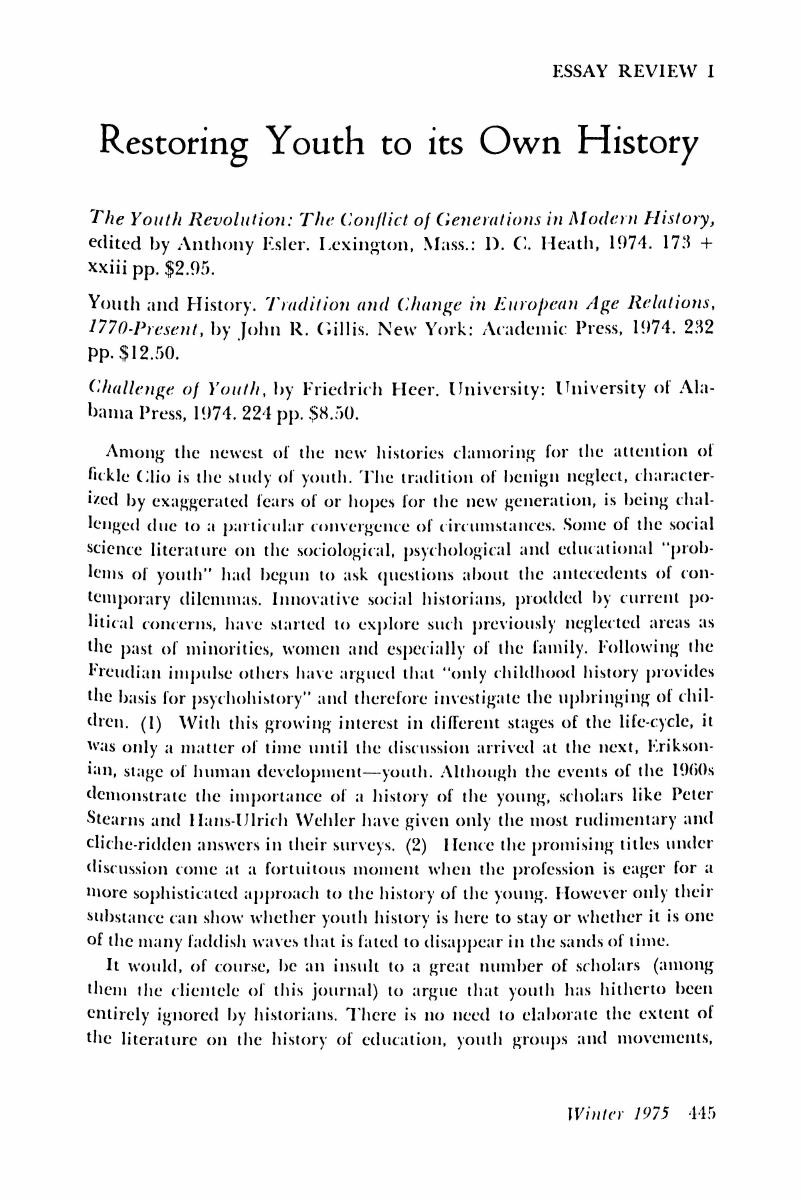Published online by Cambridge University Press: 02 June 2017

1. K. Hausen's lead article and the entire Special issue on “Historische Familien forschung and Demographie, Geschichte and gesellschaft, 1 (1975): 171–20. Editor's forword by Demause, Lloyd, “The History of Childhood: The Basis for Psychohistory,” History of Childhood Quarterly, 1 (1973): 1–3.Google Scholar
2. Stearns, Peter N., European Society in Upheaval: Social History Since 1750 (New York, 1975, 2nd ed.), p. 140, 232ff. Welder, H. U., Das Deutsche Kaiserreich 1871–1918 (Goettingen, 1973), p. 122ff.Google Scholar
3. Gillis, John R., “Youth and History: Progress and Prospect,” Journal of Social History, 7 (1973): 202–207.Google Scholar
4. Feuer, Lewis S., The Conflict of Generations: The Character and Significance of Student Movements (New York, 1969) and Lipset, Seymour M., Passion and Politics: Student Activism in America (Boston, 1971).Google Scholar
5. Kett, Joseph F., “Adolescence and Youth in Nineteenth Century America,” Journal of Interdisciplinary History, 2, (1971): 283–298; Fishman, Sterling, “Suicide, Sex and the Discovery of the German Adolescent,” History of Education Quarterly, 10 (1970): 170–188; and Ross, Dorothy, G. Stanley Hall: The Psychologist as Prophet (Chicago, 1972).Google Scholar
6. More honest in its limitation to Germany is the equally profusely illustrate book by Linne, Gerd, Jugend in Deutschland: Vom Sturm und Drang zur Apo (Gütersloh, 1970). In contrast to Heer, Linne is fundamentally optimistic in stressing “the socially critical, yes revolutionary thought and desire of the young ‘elite’ groups, especially of the students and literati.”Google Scholar
7. Cf. also his popularized narrative survey, Bombs, Beards and Barricades: 150 Years of Youth in Revolt (New York, 1971).Google Scholar
8. In contrast to most of the other pieces in the anthology, the choice of selections from Treitschke on the German student movement is unfortunate, since he is a particularly ambivalent and unrealiable witness. After beginning in the Burschenschaft Frankonia in Bonn, Treitschke resigned because of its political progressivism and joined a Korps in Heidelberg. Hence he was later at great pains to down-play his youthful folly which he did by caricaturing the entire Burschenschaft movement in comparison with hard-headed Bismarckian Real-politik, Cf. my own, “The Sources of German Student Dissent, 1815–1948,” in Stone, L., ed., The University in Society, (Princeton, 1974), II, pp. 533–569, specially N.38.Google Scholar
9. Esler, Anthony, “Youth in Revolt: The French Generation of 1930,” in Bezucha, R. J., ed., Modern European Social History (Lexington, 1972), 301–334. For a more complete summary of the literature and discussion of the problems involved cf. also Spitzer, Alan B., “The Historical Problem of Generations,” American Historical Review, 78 (1973): 1353–1385.CrossRefGoogle Scholar
10. Gillis's previous writings have dealt mainly with The Prussian Bureaucracy in Crisis, 1840–1860 (Stanford, 1971).Google Scholar
11. The relationship between modernization and revolt is much more complex than Gillis makes out, since in some countries like England and the U.S. there was little rebellion. Cf. Frisch, John R., “Youth Culture in America, 1790–1865,” Ph.D. diss, Univ. of Missouri, Columbia, Mo. (1970).Google Scholar
12. For a less onesided analysis of early 19th century German youth cf. Wegert, Karl H., “Radicalism and Youth: Hessen-Nassau, 1806–1819,” (unpublished paper, Toronto, 1974, based on his recent dissertation).Google Scholar
13. A more complex exploration of the economics of adolescence is the paper by Troen, Selwyn, “The Discovery of the Adolescent by American Educational Reformers 1900–1920: An Economic Perspective” delivered at the AHA meeting in Chicago, December 1974 which will be reprinted in a revised version in a collection edited by Stone, Lawrence.Google Scholar
14. Cf. Kett, Joseph F., “The Hollow Youth: American Educators and the Redefinition of Adolescence, 1900–1920,” paper delivered at the 1974 Chicago AHA meeting. See also Saul, K., “Der Kampf um die Jugend zwischen Volksschule und Kaserne. Ein Beitrag zur ‘Jugendpflege’ im Wilhelminischen Reich 1890–1914,” Militärgeschichtliche Mitteilungen, 9 (1971): 97–144.Google Scholar
15. Already stated by Gillis in “Conformity and Rebellion: Contrasting Styles of English and German Youth, 1900–1933,” History of Education Quarterly, 13 (1973): 249–260.CrossRefGoogle Scholar
16. There is no need to dwell on annoying trivia, such as the unorthodox system of citation (only names, sometimes even without page number), the vagaries of the German spelling or the trendiness of some of the language, i.e. “interface” (p. x).Google Scholar
17. One cannot help but wonder what would happen to the conclusion about “equilibrium” of paternity and fraternity in a city of the Ruhr valley or in a rural area after the agricultural revolution (a topic entirely neglected). C.f. Wehler, H.-J., Modernisierungs theorie und geschichte (Goettingen, 1975).Google Scholar
18. For the source problem of Bremner, B. H., ed., Children and Youth in America (Cambridge, Mass., 1970f.). One of the important older works not mentioned is Roessler, W., Jugend im Erziehangsfeld (Düsseldorf, 1957). Cf. now also the recent symposium on Jugend in der gessellschaft (Munich, 175). especially the chapters by Mühlmann and Rassem.Google Scholar
19. Cf. now also Jeismann, K. E., Das Preussiche Gymnasium in Staat und Gesellschaft. Die Entastehung des Gymnasiums als Schule des Staates und der Gebildeten, 1787–1817 (Stuttgart, 1974).Google Scholar
20. See e.g. Kreuzberger, Wolfgang, Studenten und Politik, 1918–1933. Der Fall Freiburg im Breisgau (Goettingen, 1972) and the forthcoming studies by Michael Kater and M. S. Steinberg.CrossRefGoogle Scholar
21. Cremin, Lawrence A., American Education: The Colonial Experience 1607–1783 (New York, 1970) and Vesey, Lawrence R., The Emergence of the American University (Chicago, 1965) for instance hardly mention adolescence and youth.Google Scholar
22. This is the question asked by James Zoll in his inaugural lecture, 1914: The Unspoken Assumptions (London, 1969). Historians will have to pay more attention to the literature on political socialization, as discussed by Fred I. Greenstein in his article in vol. 14 of the International Encyclopedia of the Social Sciences (New York, 1968) and by Hermann, U. in “Historisch-systematische Dimension der Erziehungswissenschaft,” Wörterbuch der Erziehung (Munich, 1974). 283–289.Google Scholar
23. Spitzer, “Generations,” especially p. 1385. One might be tempted to speculate that the cult of youth is partially a result of a double standard similar to that between the sexes, i.e. that the glorification of the young is a fig-leaf for their dependence.Google Scholar